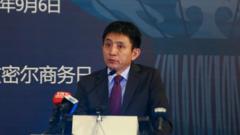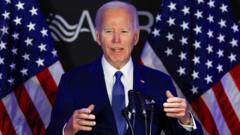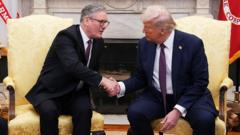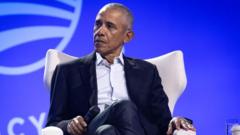As tariffs reach unprecedented levels with potential hikes of up to 104% on imports from China and the EU, US businesses face a dilemma of how to navigate this rapidly changing trade landscape, impacting prices, jobs, and overall economic stability.
Tariff Turbulence: Businesses Brace for Economic Uncertainty Amidst Trump's New Trade Laws

Tariff Turbulence: Businesses Brace for Economic Uncertainty Amidst Trump's New Trade Laws
President Trump's latest round of tariff hikes is sending shockwaves through global markets and leaving businesses in jeopardy as they grapple with the implications.
As President Donald Trump enacts a new series of tariffs that defy over half a century of established trade norms, anxiety ripples through the business sector. The latest tariffs, which took effect shortly after midnight Wednesday, impose substantial import taxes on goods from major trading partners like China and the European Union. These actions are framed by the administration as necessary to bolster America's manufacturing capabilities—a pillar deemed crucial for national security. However, the repercussions are potentially catastrophic, affecting over $2 trillion in imports and elevating the overall effective tariff rate in the US to its highest level in over a century.
Consumer goods, particularly clothing, could see staggering price increases of approximately 33%. Analysts caution that this surge in tariffs may bring about significant global economic fallout, resulting in plummeting sales figures in the US, contraction of international trade, and diminished production rates abroad. As the stock market tumbles and political pressure mounts, the White House attempts to alleviate concerns by hinting at potential trade discussions with nations like Japan, Vietnam, and South Korea. However, Trump’s recent statements suggest a reluctance to provide the exemptions commonly seen during his initial term, raising questions about how negotiations might evolve.
The situation appears dire as a collision course with China looms. The White House confirmed plans to proceed with an additional 50% tariff on Chinese imports, augmenting the already high 54% duties imposed earlier—unless China retracts its retaliatory positions. In a recent statement, the Chinese embassy in Washington characterized Trump's actions as aggressive bullying, with officials warning that Beijing would maintain its stance amid what they view as threats.
Fears of economic instability have paralyzed US businesses long entrenched in relationships with Chinese suppliers. Jay Foreman, CEO of Basic Fun!, highlighted the predicament faced by many firms as they halt shipments and stockpile existing inventory. “We just have to hold our shipments until this gets resolved. If it doesn’t, I’ll just have to sell what I already have,” he lamented.
While the US Trade Representative’s office acknowledged the challenges posed by the new tariffs, they emphasized an unwavering commitment to tackle the long-standing trade deficit. However, no clear timelines for negotiations have been established, leaving businesses in a limbo.
US stock markets continue to falter, with the S&P 500 now down nearly 12% since last week's announcement and trading at levels not seen in over a year. International markets also reflect this turmoil, with indices in Japan and Germany feeling the heat of uncertainty, as investors assess the far-reaching implications.
Experts warn that the instability is already taking a toll on the economy, affecting job stability and household purchasing power. Predictions suggest a loss of 600,000 jobs and a decrease of approximately $3,800 in purchasing power for the average American family due to the tariffs. “This market turmoil stems primarily from uncertainty,” noted Ernie Tedeschi, emphasizing how unpredictability breeds hesitation in both businesses and consumers. With no resolution in sight, the path remains foggy as the trade conflict escalates.






















